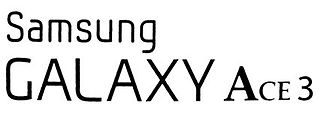Google Nexus is a discontinued line of consumer electronic devices that run the Android operating system. Google managed the design, development, marketing, and support of these devices, but some development and all manufacturing were carried out by partnering with original equipment manufacturers (OEMs). Alongside the main smartphone products, the line also included tablet computers and streaming media players; the Nexus started out in January 2010 and reached its end in October 2016, replaced by Google Pixel.
HTC Sensation XL is touchscreen-based, slate-sized Android smartphone manufactured by HTC. It was announced on October 6, 2011 by HTC on their Beats Audio event at London and released worldwide on October 26, 2011. The Sensation XL was HTC's second phone that was equipped with Beats Audio sound enhancer technology, after the earlier HTC Sensation XE. Two editions of the HTC Sensation XL were released; the only difference between these two models was that the limited edition was shipped with is Beats Solo's while the normal edition was shipped with the in-ear earphones of those on the Sensation XE.

The HTC One X is a touchscreen-based, slate-sized smartphone designed and manufactured by HTC. It was released running Android 4.0.3, with the HTC Sense 4.0 skin. The One X is powered by the NVIDIA Tegra 3 for most international GSM carriers, making this the first HTC phone to be equipped with a quad-core processor, while a variant which is LTE capable is powered by the Qualcomm Snapdragon S4 dual-core 1.5 GHz Krait processor. The One X was announced on February 26, 2012, at the Mobile World Congress and was HTC's sixth flagship product, leading the HTC One series from the time of its release through April 2013, when its successor the HTC One (M7) was announced.

The HTC One S is a premium smartphone designed and manufactured by HTC as part of the HTC One series which has Beats Audio and runs the Android 4.0 "Ice Cream Sandwich" mobile operating system with HTC Sense. Announced by HTC on 26 February 2012, the HTC One S was scheduled for official release on 2 April 2012. The first phones were sold on March 30. In the United States, the One S is carried by T-Mobile and Solavei.

The Samsung Galaxy Ace 3 (GT-S7270/GT-S7272/GT-S7275R) is a smartphone manufactured by Samsung that runs the Android operating system. Announced and released by Samsung in June 2013, the Galaxy Ace 3 is the successor to the Galaxy Ace 2.
The HTC Desire 600 is an Android smartphone developed by the Taiwanese manufacturer HTC.

The HTC One Max is an Android phablet smartphone designed and manufactured by HTC. The device is a larger variant of HTC's 2013 flagship high-end smartphone, the HTC One, notably incorporating a 5.9-inch display and fingerprint recognition features.
The HTC Desire 601 is an Android smartphone designed and manufactured by HTC. The Desire 601 is a mid-range device carrying design traits from the HTC One and One Mini, utilizing a dual-core processor, 4.5-inch qHD display, and offering LTE support.

The HTC Desire 610 is an Android-based smartphone designed and manufactured by HTC. It is an affordable smartphone part of the Desire range of mid-range handsets, and was aimed at the same market sector with devices such as the Motorola Moto G, Sony Xperia M2 and Nokia Lumia 735. It was announced on 24 February 2014 at Mobile World Congress 2014 in Barcelona, Spain. It was released in China in March 2014, in Europe starting April 2014 and in Australia on 5 August 2014.

The Nokia X2 is an entry-level smartphone which was announced and released by Microsoft Mobile on 24 June 2014. It is the successor of the Nokia X, being the first smartphone running version 2.0 of the Android-based Nokia X platform operating system. The Nokia X family of Android phones was discontinued on July 17, 2014.
The HTC One (E8) is a high-end Android smartphone released by HTC in 2014. It has been described as a cheaper version of the HTC One (M8), and the two devices share many similar features.

The HTC One M9 was an Android smartphone manufactured and marketed by HTC. The M9 was officially unveiled in a press conference at Mobile World Congress on March 1, 2015, and it was released worldwide on April 10, 2015. It is the successor to HTC One (M8). Now there are many other models and new devices included into this HTC.
The HTC Desire 620 is an Android-based smartphone designed and manufactured by HTC. It is part of the Desire range of mid-range handsets. It was announced on 29 November 2014 in Taiwan. It was announced for the European market on 9 December 2014.

The Huawei Honor 4X is a mid-range Android smartphone manufactured by Huawei as part of the Huawei Honor X series. It was released in October 2014, and received generally positive reviews.
The HTC Desire 300 is a low-end Android smartphone released by HTC in 2013. The phone was announced on 3 September 2013 in London, England. It was stated that the device would be available in October 2013 in select markets.

The HTC Desire 500 is a low-mid-range Android smartphone released by HTC in 2013. On 23 July 2013, HTC Desire 500 was announced in Taiwan. On 7 August 2013, the device was unveiled for the European market.
The HTC Desire 626 is a mid-range Android smartphone released by HTC in 2015. It comes in single SIM and dual SIM models.
The HTC Desire 616 is a mid-range Android smartphone released by HTC in 2014. It is the first HTC smartphone with an octa-core processor. It was launched on 7 July 2014 in Asian markets. On 11 July 2014, the phone was launched in India for 16900 INR.
Oppo phones are smartphones produced by the partially state-owned Chinese company Oppo, running in several countries.









